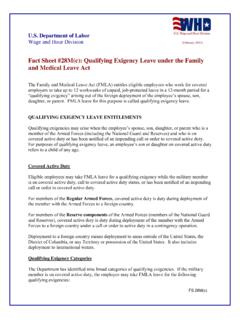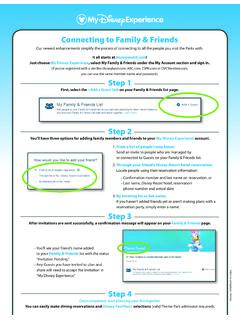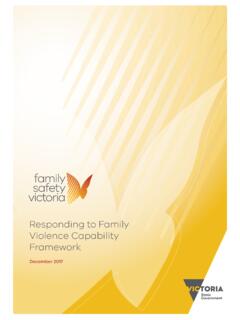Transcription of Part I Section 223 – Health Savings Accounts—HDHP Family ...
1 Part I Section 223 Health Savings Accounts HDHP Family Coverage Rev. Rul. 2005-25 ISSUES 1. Is a married individual who otherwise qualifies as an eligible individual eligible to contribute to a Health Savings Account (HSA) under Section 223 of the Internal Revenue Code (the Code) if the individual s spouse has non-HDHP Family coverage that does not cover the individual? 2. If the individual is eligible to contribute to an HSA, what is the maximum contribution limit? FACTS Situation 1 H and W are a married couple and both are age 35. Throughout 2005, H has self-only coverage under a high deductible Health plan (HDHP) as defined in Section 223(c)(2) with an annual deductible of $2,000.
2 H has no other Health coverage, is not enrolled in Medicare and may not be claimed as a dependent on another taxpayer s return. W has non-HDHP Family coverage for W and H s and W s two dependents, but H is excluded from W s coverage. Situation 2 The same facts as Situation 1, except that H has HDHP Family coverage as defined in Section 223(c)(2) for H and one of H s and W s dependents with an annual deductible of $5,000. W has non-HDHP Family coverage for W and H s and W s other dependent. H is excluded from W s coverage. 2 Situation 3 The same facts as Situation 1, except that H has HDHP Family coverage for H and H s and W s two dependents with an annual deductible of $5,000.
3 W is not covered under H s Health plan and has no other Health plan coverage. LAW AND ANALYSIS Section 223(a) allows a deduction for contributions to an HSA for an eligible individual. Section 223(c)(1)(A) defines eligible individual with respect to any month, as an individual who, in addition to other requirements, is covered under an HDHP on the first day of such month and is not, while covered under an HDHP, covered under any Health plan which is not a high deductible Health plan, and which provides coverage for any benefit which is covered under the high deductible Health plan. An eligible individual may also have permitted insurance, and certain disregarded coverage in addition to an HDHP.
4 A plan does not fail to be treated as an HDHP merely because it covers preventive care without a deductible. An HDHP is a Health plan that satisfies certain requirements with respect to minimum annual deductibles and maximum annual out-of-pocket expenses. Section 223(c)(2)(A). Family coverage is any coverage other than self-only coverage ( , an HDHP covering one eligible individual and at least one other individual (whether or not the other individual is an eligible individual)). Section 223(c)(4); Q&A-12 of Notice 2004-50, 2004-33 196. Only eligible individuals may contribute to an HSA. The maximum annual contribution limit is the sum of the limits determined separately for each month.
5 For an individual who is eligible during the entire calendar year 2005, the contribution limit is 3the lesser of the annual deductible under the HDHP (minimum of $1,000 for self-only coverage and $2,000 for Family coverage) or $2,650 for self-only coverage and $5,250 for Family coverage. Rev. Proc. 2004-71 , 2004-49 1184. Section 223(b)(5) provides special rules for married individuals. In general, if either spouse has Family coverage, both spouses are treated as having only such Family coverage. Also, if each spouse has Family coverage under different Health plans, both spouses are treated as having Family coverage under the plan with the lowest deductible. However, if a spouse has HDHP Family coverage and the other spouse has non-HDHP self-only coverage, the spouse with the HDHP Family coverage is an eligible individual and may contribute to an HSA up to the amount of the annual contribution limit.
6 Because the other spouse is covered by a non-HDHP and is therefore not an eligible individual, the other spouse may not contribute to an HSA, notwithstanding the special rule in Section 223(b)(5) treating both spouses as having Family coverage. Q&A-31 of Notice 2004-50. An eligible individual who attains age 55 before the close of the calendar year may make a catch-up HSA contribution (up to $600 in 2005). Section 223(b)(3). In Situation 1, H has HDHP self-only coverage and no other Health coverage, is not enrolled in Medicare and may not be claimed as a dependent on another taxpayer s return. Although W has non-HDHP Family coverage, H is not covered under that Health plan.
7 H is therefore an eligible individual as defined in Section 223(c)(1). The special rules for married individuals under Section 223(b)(5) do not apply because W s non-HDHP Family coverage does not cover H. Thus, H remains an eligible individual and H may contribute up to $2,000 to an HSA (lesser of the HDHP deductible for self-only 4coverage or $2,650) for 2005. H may not make the catch-up contribution under Section 223(b)(3) because H is not age 55 in 2005. W has non-HDHP coverage and is therefore not an eligible individual. In Situation 2, H has HDHP Family coverage for one of H s and W s dependents and W has non-HDHP Family coverage for W and H s and W s other dependent.
8 Because the non-HDHP Family coverage does not cover H, the special rules in Section 223(b)(5) do not affect H s eligibility to make HSA contributions up to H s annual HSA contribution limit. H may therefore contribute up to $5,000 to an HSA (the lesser of the Family HDHP deductible or $5,250). W has non-HDHP coverage and is therefore not an eligible individual. In Situation 3, H has HDHP Family coverage for H and H s and W s two dependents. H may contribute to up to $5,000 to an HSA (the lesser of the Family HDHP deductible or $5,250). Because H s Family coverage does not cover W, the special rules under Section 223(b)(5) do not apply to treat W as having Family coverage.
9 W has no Health plan coverage and is therefore not an eligible individual. HOLDINGS 1. An individual who otherwise qualifies as an eligible individual does not fail to be an eligible individual merely because the individual s spouse has non-HDHP Family coverage, if the spouse s non-HDHP does not cover the individual. Accordingly, that individual may contribute to an HSA. 2. The maximum amount under Section 223(b) that an eligible individual may contribute to an HSA is based on whether the individual has self-only or Family HDHP coverage. 5 DRAFTING INFORMATION The principal author of this revenue ruling is Elizabeth Purcell of the Office of Division Counsel/Associate Chief Counsel (Tax Exempt and Government Entities).
10 For further information regarding this revenue ruling, contact Ms. Purcell at (202) 622-6080 (not a toll-free call).













